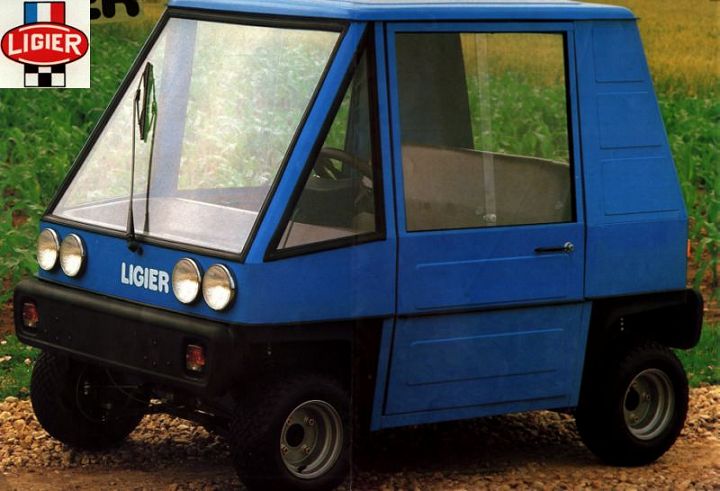Description
The Ligier JS4 was one of the most distinctive and unusual vehicles ever produced by the French manufacturer Ligier—a small, boxy microcar that reflected both the economic and cultural realities of late-1970s France. Introduced in 1980, the JS4 was part of a new generation of lightweight, license-exempt cars built to comply with French “voiture sans permis” regulations, which allowed people without a full driving licence to operate small, low-speed vehicles. Although radically different from the Formula One and endurance racing cars for which Ligier was best known, the JS4 carried the same nameplate heritage and engineering precision that characterized the company’s racing pedigree.
Ligier, founded by former racing driver Guy Ligier, had achieved international recognition through its sports prototypes and Formula One cars of the 1970s. By the end of that decade, however, the company sought to diversify its operations and take advantage of the growing demand for compact, economical urban vehicles. The JS4 (the “JS” prefix honouring Ligier’s late friend and racing partner Jo Schlesser) was the company’s first serious entry into the small-car market and represented a complete shift from high-speed racing machines to practical mobility solutions.
The JS4 was powered by a single-cylinder 49 cc two-stroke engine supplied by Motobécane, later replaced in some versions by Lombardini and Sachs four-stroke engines. Power output was modest—around 3.5 horsepower—but sufficient to propel the car to its legislated maximum speed of 45 km/h (28 mph). Power was transmitted through a continuously variable transmission (CVT), providing smooth acceleration without gear changes, and drive was delivered to the rear wheels. The simplicity of the drivetrain made the JS4 easy to maintain and very economical to run, consuming roughly 3 litres of fuel per 100 kilometres.
The chassis consisted of a simple tubular steel frame with independent suspension at the front and a solid rear axle. The bodywork was made from glassfibre-reinforced plastic panels mounted on the frame, giving the car its distinctive angular, box-like appearance. With a total length of just 2.1 metres and a width of 1.3 metres, the JS4 was compact enough to navigate narrow streets and park almost anywhere, while its relatively tall stance offered good visibility for the driver.
Stylistically, the JS4 was unapologetically utilitarian. Its square body featured flat panels, large rectangular windows, and a near-vertical rear end with a simple lift-up tailgate. The front end carried rectangular headlights and a small black grille emblazoned with the Ligier badge, while the rear housed minimalist combination lamps. The car’s most striking feature was its plastic cladding and upright, almost toy-like proportions, which gave it a character that was both charming and eccentric.
The interior was equally functional. The JS4 seated two adults on simple vinyl-covered seats, with a basic dashboard containing only the essential controls: speedometer, fuel gauge, and switches for lights and wipers. There was no conventional door lock or key ignition in many early versions; instead, the engine could be started with a simple toggle switch. Ventilation was rudimentary, and heating was optional. Nevertheless, the car provided a dry, enclosed environment for commuting—an appealing prospect for people living in rural areas or small towns where public transport was limited.
On the road, the JS4 was slow but steady. Its light weight, around 300 kilograms, made it surprisingly nimble in tight spaces, and the CVT transmission ensured seamless progress in traffic. The small wheels and basic suspension gave a firm ride, but the car’s stability and predictability at low speeds made it easy to handle even for inexperienced drivers. It was particularly popular among older drivers, rural residents, and those who had lost or never obtained a full driving licence.
Ligier produced several variants of the JS4 during its short production run, including a commercial version with a small cargo compartment at the rear. Later evolutions featured slightly more powerful engines, improved weather sealing, and updated interiors. Despite these refinements, the car retained its minimalist appeal and utilitarian design throughout its life.
Production of the Ligier JS4 lasted until around 1983, when it was replaced by the more modern and refined JS6. Although it was never a commercial blockbuster, the JS4 established Ligier as a serious player in the emerging microcar segment and laid the foundation for the company’s long-term success in the “voiture sans permis” market—a sector it continues to dominate decades later.
Today, the Ligier JS4 is viewed as a quirky and charming piece of French automotive history. Its unconventional design and connection to a respected racing manufacturer make it a fascinating curiosity among collectors of microcars and unusual vehicles. While it may not share the glamour of Ligier’s Formula One machines, the JS4 represents another side of the company’s ingenuity—the ability to adapt, innovate, and build vehicles suited to the needs of ordinary people rather than the racetrack.
The JS4 captured the essence of its time: a practical response to fuel crises, changing regulations, and the growing demand for accessible mobility. It was humble yet distinctive, functional yet full of character—a small car built by a company that once chased speed but learned that there was also elegance in simplicity.
